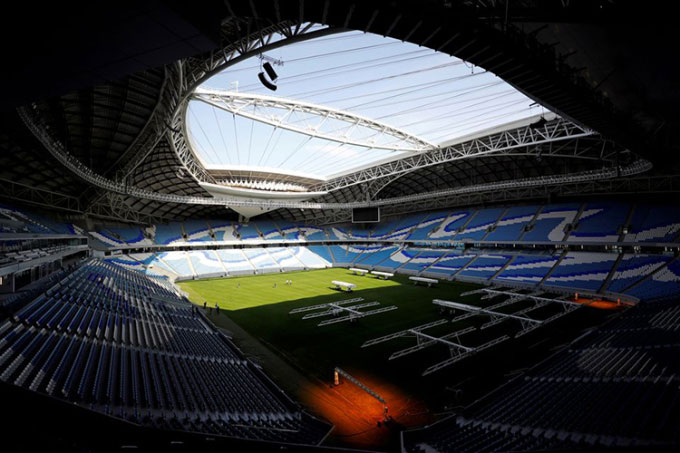Despite the harsh desert conditions, Qatar has “excellently completed” the development of grass surfaces for the stadiums hosting the 2022 World Cup.
To win the bid for the FIFA World Cup 2022, Qatar committed to developing perfect grass surfaces to ensure the matches are held with the highest quality of play. This was a challenge for a desert nation “hot as a frying pan,” but they succeeded.

Al Janoub Stadium in Qatar, one of the 8 official venues for the 2022 World Cup. (Photo: Reuters)
In 2018, the Qatar Supreme Committee for Delivery & Legacy (SC) established a research station for grass with a “scale never seen before in the region” – known as the SC Grass Nursery – located north of the capital Doha, where experts conducted research and experiments on over 12 different types of grass to find the most suitable variety for the stadiums, according to Expat Sport.
“The grass grown at this unique nursery is specially developed in Qatar to withstand the country’s desert climate and the rigors of a competitive tournament like the FIFA World Cup. Another unique aspect is the irrigation system that uses recycled water sourced from the nearby North Doha wastewater treatment plant, ensuring this is a sustainable project in every way”, said Yasser Al Mulla, Director of Landscape & Sports Field Management at SC.
The project spans an area of up to 880,000m2, roughly equivalent to 166 football fields. In addition to the grass on the field, greenery and shrubs were also planted to enhance the landscape at the tournament venues. A total of 16,000 trees, 679,000 shrubs, and 425,000m2 of grass are carefully tended to ensure they are ready for the entire tournament and beyond.
“The SC Grass Nursery promotes environmental sustainability by cultivating various types of plants from different regions of Qatar. The project also introduces new plant species to the country’s ecological landscape, thus contributing to biodiversity conservation,” Workers’ Welfare quoted SC Secretary General HE Hassan Al Thawad.
The SC Grass Nursery located north of Doha, Qatar. (Video: Reuters).
Qatar’s Minister of Municipality and Environment Mohammad Bin Abdullah Al-Rumaih believes that this facility is “a long-term investment” that will continue to benefit the country after the tournament concludes.
“The nursery reflects the strong relationship that exists between SC, the Public Works Authority (Ashghal), and the Ministry of Municipality and Environment. It not only provides affordable grass for the World Cup stadiums but also for the local community after the tournament. The sustainable concept is deeply ingrained in this project, reminding us all of the social and environmental legacy that the World Cup will leave for future generations in Qatar,” added Dr. Saad Ahmed Al Mohannadi, Chairman of Ashghal.
Currently, a team of experts is maintaining 144 lush green fields, including 8 stadiums and 136 training pitches. Since September, they have been blowing cold air through nozzles directly onto the fields to ensure the grass thrives in the harsh autumn conditions – when temperatures can reach up to 40°C – and does not experience “shock” when the weather turns cold during the World Cup.
According to Reuters, the 28-day period of the 2022 World Cup, starting from November 20, is likely the most challenging time of the year for the grass, as Qatar’s weather transitions from the extreme heat of summer to the mildness of winter.
“Mimicking” winter is just one of the tricks that experts have applied over the past 14 years to improve grass quality and increase the number of playing fields in Qatar. Developing and maintaining lush green surfaces is truly a costly process.
Qatar has been transporting 140 tons of grass seed annually from the United States using specialized aircraft, while the fields are irrigated with desalinated seawater, which consumes a significant amount of energy.
Haitham Al Shareef, a Sudanese civil engineer who worked at the 2022 World Cup stadium, stated that each field requires 10,000 liters of desalinated water daily in winter and 50,000 liters in summer.
Additionally, to combat the risk of fungal outbreaks and diseases on the grass, Qatar regularly maintains the fields with chemicals, lawn mowers, and underground systems to extract excess moisture, according to a UEFA consultant.
The grass on the stadiums, training fields, and nursery is always carefully maintained to be ready for the World Cup. (Video: Reuters).
In case of an emergency replacement, Qatar is also prepared with 425,000m2 of grass reserves at the nursery. According to Mohamed Al Atwaan, a former project manager at Stadium 974, grass can be harvested, transported to the stadium, and replaced within 8 hours.
- The organizers did not disclose how much the grass program has cost Qatar, but the country has spent billions of USD on infrastructure over the past decade to prepare for the world’s biggest football event.
- The stadium hosting the opening ceremony of the 2022 World Cup built by a Vietnamese company: Beautiful as a new wonder of the world
- Inside the fan village at the 2022 World Cup
- FIFA World Cup 2022 uses new offside technology


















































